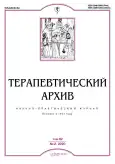Клинико-иммунологические и морфологические особенности различных вариантов аутоиммунного гепатита
- Авторы: Сандлер Ю.Г.1, Салиев К.Г.1, Бацких С.Н.1, Хомерики С.Г.1, Хайменова Т.Ю.1, Дорофеев А.С.1, Збикина Е.С.1, Винницкая Е.В.1
-
Учреждения:
- ГБУЗ «Московский клинический научно-практический центр им. А.С. Логинова» Департамента здравоохранения г. Москвы
- Выпуск: Том 92, № 2 (2020)
- Страницы: 43-47
- Раздел: Передовая статья
- URL: https://journals.rcsi.science/0040-3660/article/view/33900
- DOI: https://doi.org/10.26442/00403660.2020.02.000536
- ID: 33900
Цитировать
Полный текст
Аннотация
Диагностика аутоиммунного гепатита (АИГ) остается сложной задачей ввиду отсутствия патогномоничных диагностических критериев, многообразия клинических, серологических и морфологических проявлений, когда упускаются возможности своевременно начатой иммуносупрессивной терапии (ИСТ), что влияет на исходы заболевания.
Цель исследования. Изучение клинических, биохимических, иммунологических и морфологических показателей у больных с серонегативным (СН) и серопозитивным (СП) АИГ, особенностей ответа на ИСТ.
Материалы и методы. Ретроспективное когортное исследование включило в себя 82 пациента с АИГ за период 2014–2019 гг. Все пациенты отвечали критериям системы оценки Международной группы по изучению аутоиммунного гепатита (IAIHG, 1999). Были проанализированы клинические, лабораторные и морфологические характеристики АИГ. Ответ на терапию оценивали по АЛТ и IgG через 6 и 12 мес после начала ИСТ. Материалы исследования были подвергнуты статистической обработке с использованием методов параметрического и непараметрического анализа. Статистический анализ проводился с использованием программы Statistica 13.3 (разработчик – StatSoft Inc., США).
Результаты. Из 82 пациентов 67 (81,70%) обследованных пациентов составили женщины, медиана возраста – 54 года (от 38 до 70 лет). Пациенты, которые соответствовали диагнозу «вероятный АИГ» согласно IAIHG, составили 85,4% (70/82). Почти все – 96% (79/82) – имели морфологические признаки пограничного (интерфейс-гепатит) гепатита с лимфо/плазмоцитарной инфильтрацией; эмпериополез – 60% (49/82), розеткообразование – 23% (19/82). Больные СН АИГ составили 37% (30/82), СП АИГ – 63% (52/82). Сравнительный анализ продемонстрировал, что клинические проявления АИГ у больных СН и СП АИГ одинаковы, в то время как частота встречаемости иммуноассоциированных заболеваний достоверно выше в группе СН АИГ. Морфологическая картина в двух группах АИГ идентична как в типичных, так и в «атипичных» проявлениях. Число ответивших на ИСТ составило среди СН АИГ 63% (19/30) vs СП АИГ 67% (35/52), достоверно не отличались (p=0,529). Обращает на себя внимание то, что пациентов с выраженным циррозом печени (ЦП) в группе СН АИГ диагностировано в 2 раза больше, чем в группе СП АИГ: 37% vs 17% (p=0,089).
Заключение. Сравнительный анализ клинико-лабораторных, морфологических и клинических проявлений в группах СН и СП АИГ не показал статистически значимых достоверных различий; это может свидетельствовать о том, что СН и СП АИГ – грани одного заболевания. Возможно, аутоантитела (АТ) не могут быть идентифицированы в рамках известного спектра АТ, или АТ имеют замедленную экспрессию, или же они подавляются иммунной системой. В любом случае подозрения на АИГ, при отсутствии АТ, рекомендуется проведение БП для своевременной диагностики АИГ и ИСТ. Тот факт, что ЦП гораздо чаще диагностирован в группе СН АИГ, может быть обусловлен более поздней диагностикой, что ведет к несвоевременной ИСТ. Вызывает интерес более частая ассоциация СН АИГ с другими иммуноассоциированными заболеваниями, что требует более глубокого изучения этого вопроса. Многообразие клинических проявлений АИГ требует дальнейшего изучения, выделения клинических фенотипов с четкой характеристикой, что в дальнейшем может помочь в прогнозировании ответа на ИСТ и своевременно выявлять потенциально проблемных пациентов.
Полный текст
Открыть статью на сайте журналаОб авторах
Юлия Григорьевна Сандлер
ГБУЗ «Московский клинический научно-практический центр им. А.С. Логинова» Департамента здравоохранения г. Москвы
Автор, ответственный за переписку.
Email: sandlerjulia2012@gmail.com
ORCID iD: 0000-0003-4291-812X
к.м.н., с.н.с. научно-исследовательского отд. гепатологии
Россия, МоскваКирилл Германович Салиев
ГБУЗ «Московский клинический научно-практический центр им. А.С. Логинова» Департамента здравоохранения г. Москвы
Email: sandlerjulia2012@gmail.com
ORCID iD: 0000-0002-4581-7052
м.н.с. отд. гепатологии
Россия, МоскваСергей Николаевич Бацких
ГБУЗ «Московский клинический научно-практический центр им. А.С. Логинова» Департамента здравоохранения г. Москвы
Email: sandlerjulia2012@gmail.com
ORCID iD: 0000-0002-5917-203X
к.м.н., с.н.с. отд. гепатологии
Россия, МоскваСергей Германович Хомерики
ГБУЗ «Московский клинический научно-практический центр им. А.С. Логинова» Департамента здравоохранения г. Москвы
Email: sandlerjulia2012@gmail.com
ORCID iD: 0000-0003-4308-8009
д.м.н., проф., зав. лаб. патоморфологии
Россия, МоскваТатьяна Юрьевна Хайменова
ГБУЗ «Московский клинический научно-практический центр им. А.С. Логинова» Департамента здравоохранения г. Москвы
Email: sandlerjulia2012@gmail.com
ORCID iD: 0000-0002-4599-4040
к.м.н., зав. отд-нием заболеваний печени
Россия, МоскваАлексей Сергеевич Дорофеев
ГБУЗ «Московский клинический научно-практический центр им. А.С. Логинова» Департамента здравоохранения г. Москвы
Email: sandlerjulia2012@gmail.com
ORCID iD: 0000-0001-9754-7579
м.н.с. лаб. научно-диагностических исследований и лаб. клинической иммунологии
Россия, МоскваЕвгения Сергеевна Збикина
ГБУЗ «Московский клинический научно-практический центр им. А.С. Логинова» Департамента здравоохранения г. Москвы
Email: sandlerjulia2012@gmail.com
ORCID iD: 0000-0003-2195-9643
м.н.с. научно-исследовательского отд-ния гепатологии
Россия, МоскваЕлена Владимировна Винницкая
ГБУЗ «Московский клинический научно-практический центр им. А.С. Логинова» Департамента здравоохранения г. Москвы
Email: sandlerjulia2012@gmail.com
ORCID iD: 0000-0002-0344-8375
д.м.н., зав. отд. гепатологии
Россия, МоскваСписок литературы
- Zachou K, Muratori P, Koukoulis GK, Granito A, Gatselis N, Fabbri A, et al. Review article: autoimmune hepatitis – current management and challenges. Aliment Pharmacol Ther. 2013;38:887-913. doi: 10.1111/apt.12470
- Czaja AJ. Autoantibody-negative autoimmune hepatitis. Dig Dis Sci. 2012 Mar;57(3):610-24. doi: 10.1007/s10620-011-2017-z
- Czaja AJ. Cholestatic phenotypes of autoimmune hepatitis. Clin Gastroenterol Hepatol. 2014;12:1430-8. doi: 10.1016/j.cgh.2013.08.039
- Czaja AJ. Diagnosis and Management of Autoimmune Hepatitis: Current Status and Future Directions. Gut Liver. 2016;10(2):177-203. doi: 10.5009/gnl15352
- Czaja AJ. Autoantibody-negative autoimmune hepatitis. Dig Dis Sci. 2012 Mar;57(3):610-24. doi: 10.1007/s10620-011-2017-z
- European Association for the Study of the Liver. EASL Clinical Practice Guidelines: Autoimmune hepatitis. J Hepatol. 2015;63:971-1004. doi: 10.1016/j.jhep.2015.09.016
- Czaja AJ. Autoantibody-negative autoimmune hepatitis. Dig Dis Sci. 2012 Mar;57(3):610-24. doi: 10.1007/s10620-011-2017-z
- Dhruv L, Savio J. Autoimmune hepatitis: Appraisal of current treatment guidelines. World J Hepatol. 2018 Dec 27;10(12):911-23. doi: 10.4254/wjh.v10.i12.911
- Ивашкин В.Т., Буеверов А.О., Маевская М.В., Абдулганиева Д.И.; Российская гастроэнтерологическая ассоциация, Российское общество по изучению печени. Клинические рекомендации по диагностике и лечению аутоиммунного гепатита. 2013. Доступно по ссылке: http://www.gastro.ru/?pageId=41 (дата обращения 15.10.2019) [Ivashkin VT, Bueverov AO, Mayevskaya MV, Abdulganieva DI; Russian Gastroenterological Association, Russian Society for the Study of Liver Clinical recommendations for the diagnosis and treatment of autoimmune hepatitis. 2013. Available at: http://www.gastro.ru/?pageId=41 (accessed 15.10.2019) (In Russ.)].
- Manns MP, Czaja AJ, Gorham JD, Krawitt EL, Mieli-Vergani G, Vergani D, Vierling JM. Diagnosis and Management of Autoimmune Hepatitis. AASLD Practice Guidelines. Hepatology. 2010;51(6):2193-213. doi: 10.1002/hep.23584
- Gleeson D, Heneghan MA. British Society of Gastroenterology (BSG) guidelines for management of autoimmune hepatitis. Gut. 2011;60:1611-29. doi: 10.1136/gut.2010.235259
Дополнительные файлы







